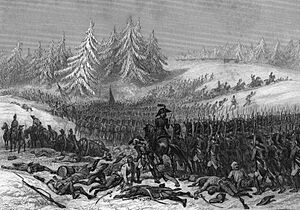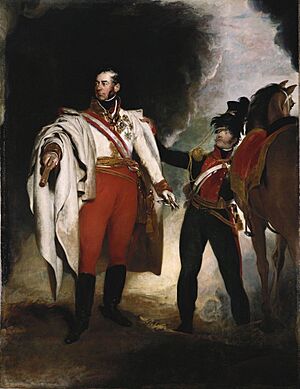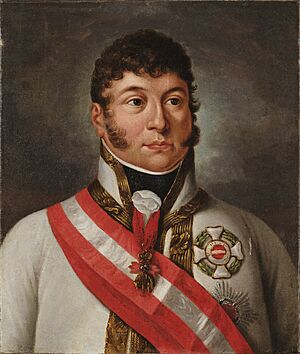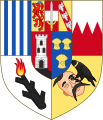Karl Philipp, Prince of Schwarzenberg facts for kids
Quick facts for kids
Generalissimo
Fürst Prince of Schwarzenberg
|
|
|---|---|

Portrait of the prince of Schwarzenberg
|
|
| Birth name | Karl Philipp |
| Born | 18 April 1771 Vienna, Habsburg monarchy |
| Died | 15 October 1820 (aged 49) Leipzig, Kingdom of Saxony |
| Allegiance | |
| Service/ |
Austrian Army during the French Revolutionary and Napoleonic Wars, Imperial Austrian Army of 1806–1867 |
| Years of service | 1789–1820 |
| Rank | Generalissimo |
| Battles/wars | French Revolutionary Wars
|
| Awards | Order of the Golden Fleece Military Order of Maria Theresa Military Order of Max Joseph Legion of Honour Order of the Holy Spirit Order of the Bath Military William Order |
| Relations | Johann Nepomuk Anton of Schwarzenberg (father) Marie Eleonore Countess of Öttingen-Wallerstein (mother) |
Karl Philipp, Prince of Schwarzenberg (born April 18, 1771 – died October 15, 1820) was an important Austrian general and Field Marshal. He started his military career in 1788. He fought against the Turks and later against France during the French Revolutionary Wars.
During the Napoleonic Wars, he led Austrian troops in the Battle of Wagram (1809). He also fought for Napoleon in Russia, winning battles like Gorodechno (1812). Later, he commanded the allied army that defeated Napoleon at the famous Battle of Leipzig (1813). This battle was a major turning point. He also helped capture Paris in 1814, which led to Napoleon giving up his power.
Schwarzenberg is best known for his role in defeating Napoleon. He helped create the Trachenberg Plan. This plan was key to the success at Leipzig and later campaigns in France. After the wars, he served as a diplomat for the Austrian Empire. He was an ambassador to Russia and represented Austria at the Congress of Vienna.
Contents
Early Life and Family
Karl Philipp was born on April 18, 1771, in Vienna. His father was Johann Nepomuk Anton of Schwarzenberg. His mother was Marie Eleonore Countess of Öttingen-Wallerstein. His family was very noble and had a long history.
Because of his important family, Karl Philipp received military training from a young age. He joined the Austrian army as a lieutenant in 1788. This was the same year he first experienced war. Later, Emperor Francis I of Austria gave Karl Philipp a special title of Fürst (Prince) for his military service.
A General's Journey
Early Military Career
In 1788, Karl Philipp joined the imperial cavalry. He fought against the Ottoman Empire in the Austro-Turkish War. This war started because Austria was an ally of Russia. Karl Philipp showed great bravery and was promoted to major in 1792. He fought in many areas of the Balkans.
Fighting in the French Revolutionary Wars
The French Revolution began in 1789. It changed France from a monarchy to a republic. Other European countries feared similar changes. They declared war on France, starting a long conflict.
Battles in France and Germany
In 1794, Schwarzenberg fought in the Le Cateau-Cambrésis. He bravely led his cavalry, breaking through French lines. He was given the Knight's Cross of the Military Order of Maria Theresa for his actions.
He also took part in Austrian victories at Amberg and Würzburg in 1796. He was promoted to major general. In 1799, he became a lieutenant general.
The Battle of Hohenlinden

In 1800, Schwarzenberg fought in the Battle of Hohenlinden. The Austrians suffered a big defeat against the French army. Schwarzenberg commanded the right side of the Austrian army. He managed to lead his troops to safety. This saved a large part of the Austrian army from being destroyed.
After this battle, Austria lost another battle at Battle of Marengo in 1800. This led to a peace treaty in 1801. Two years before, Napoleon Bonaparte had taken power in France. He later became Emperor of the French in 1803. In 1804, Karl Philipp was given the title of Prince of Schwarzenberg.
The Napoleonic Wars
Early Campaigns (1805–1812)
In 1805, during the War of the Third Coalition, Schwarzenberg commanded a division. When Napoleon surrounded Ulm, Schwarzenberg and Archduke Ferdinand managed to escape with their cavalry. However, the main Austrian army had to surrender.
In 1809, war broke out again between Napoleon and Austria. Schwarzenberg fought in the Battle of Wagram in July 1809. The Austrians lost this battle. Schwarzenberg was promoted to general of cavalry soon after.
In 1812, Austria became an ally of France. Napoleon asked Schwarzenberg to lead an Austrian army of about 30,000 men. This army joined Napoleon's huge army for the French invasion of Russia. Schwarzenberg had to balance pleasing Napoleon and not angering Russia. His troops fought bravely and won battles at Gorodetschna and Wolkowisk.
Defeating Napoleon (1813–1815)
In 1813, Napoleon's invasion of Russia failed badly. Many European nations formed the War of the Sixth Coalition against him. Austria joined the coalition after Napoleon refused peace terms. Schwarzenberg was made commander-in-chief of the allied Army of Bohemia. This was a huge army of about 230,000 men. It was his first time leading such a large force.
The Trachenberg Plan
The allied generals faced a challenge: how to defeat Napoleon's brilliant tactics. Schwarzenberg helped create the Trachenberg Plan. This plan suggested that allied armies should avoid direct battles with Napoleon himself. Instead, they would attack his other generals. They would only combine their forces to fight Napoleon when they had a clear advantage. This plan proved very successful.
The Battle of Leipzig

Schwarzenberg's army was defeated by Napoleon at the Battle of Dresden in August 1813. However, his army later defeated French forces at the Second Battle of Kulm. He then led his army north again. He played a key role in Napoleon's huge defeat at the Battle of Leipzig (October 16–18, 1813). This battle is also known as the "Battle of the Nations." Schwarzenberg, along with the emperors of Russia and Austria and the king of Prussia, directed this battle. The allied cooperation led to a major victory.
Capturing Paris
After Leipzig, the allies invaded France in 1814. Schwarzenberg attacked through Switzerland. He won battles like Battle of Bar-sur-Aube and Battle of Fère-Champenoise. His Austrian army, along with Prussian and Russian armies, surrounded Paris on March 26. After a day of fighting, the French surrendered the city. The capture of Paris on March 31, 1814, forced Napoleon to give up his power. This ended Napoleon's rule and his control over Europe.
The Hundred Days
In 1815, Napoleon escaped from Elba and returned to power. Schwarzenberg commanded a large Austrian-allied army. However, the Austrians did not have to fight. The British and Prussian armies defeated Napoleon at the Battle of Waterloo in June 1815. This finally ended the long period of wars in Europe.
Diplomatic Work
Schwarzenberg also served as a diplomat. He was the Austrian ambassador to Russia from 1806 to 1809. He was also ambassador to France from 1809 to 1814.
In 1810, he was sent to Paris to arrange the marriage between Napoleon and Archduchess Marie Louise of Austria. During a ball he hosted for the wedding, a fire broke out. Many guests died, including his own sister-in-law.
Later Life and Legacy
After the wars, Schwarzenberg's health got worse. In 1817, he suffered a stroke. In 1820, he visited Leipzig, the site of his greatest victory. There, he suffered a second stroke and died on October 15.
When he died, the Austrian Empire had three days of mourning. Even Emperor Alexander I of Russia said, "Europe has lost a hero and I a friend."
Family and Descendants
Prince Karl Philipp married Countess Maria Anna von Hohenfeld. They had three sons:
- Friedrich (1800–1870), his oldest son, was a soldier who wrote about his adventures.
- Karl II (1802–1858), his second son, became a general and governor.
- Edmund Leopold Friedrich (1803–1873), his third son, became a Field marshal in the Austrian army.
The modern Schwarzenberg family comes from his branch. They still own lands and a castle in Czech Republic.
Honours and Awards
By Country
 Habsburg monarchy:
Habsburg monarchy:
- Knight of the Military Order of Maria Theresa, May 25, 1794; Commander, 1806; Grand Cross, 1813
- Knight of the Golden Fleece, 1809
- Grand Cross of St. Stephen, 1810
- Army Cross 1813/14 in gold, 1814
- France:
 French Empire: Grand Eagle of the Legion of Honour, 1811
French Empire: Grand Eagle of the Legion of Honour, 1811 Kingdom of France: Knight of the Holy Spirit, 1816
Kingdom of France: Knight of the Holy Spirit, 1816
 Russian Empire:
Russian Empire:
- Knight of St. George, 1st Class, October 8, 1813
- Knight of St. Andrew, October 11, 1813
- Knight of St. Alexander Nevsky, October 11, 1813
 Sweden: Grand Cross of the Sword, 1st Class, February 20, 1814
Sweden: Grand Cross of the Sword, 1st Class, February 20, 1814 Kingdom of Bavaria:
Kingdom of Bavaria:
- Grand Cross of the Military Order of Max Joseph, February 27, 1814
- Knight of St. Hubert, 1814
 Kingdom of Sardinia: Knight of the Annunciation, January 4, 1815
Kingdom of Sardinia: Knight of the Annunciation, January 4, 1815 Denmark: Knight of the Elephant, April 30, 1815
Denmark: Knight of the Elephant, April 30, 1815 United Kingdom: Honorary Grand Cross of the Bath (military), August 18, 1815
United Kingdom: Honorary Grand Cross of the Bath (military), August 18, 1815 Netherlands: Grand Cross of the Military William Order, August 27, 1815
Netherlands: Grand Cross of the Military William Order, August 27, 1815 Kingdom of Hanover: Grand Cross of the Royal Guelphic Order, 1816
Kingdom of Hanover: Grand Cross of the Royal Guelphic Order, 1816
Images for kids
-
Coat of arms of the Schwarzenberg princes
-
Schwarzenberg Monument at Schwarzenbergplatz, Vienna, by Ernst Julius Hähnel
See Also
 In Spanish: Carlos Felipe de Schwarzenberg para niños
In Spanish: Carlos Felipe de Schwarzenberg para niños







